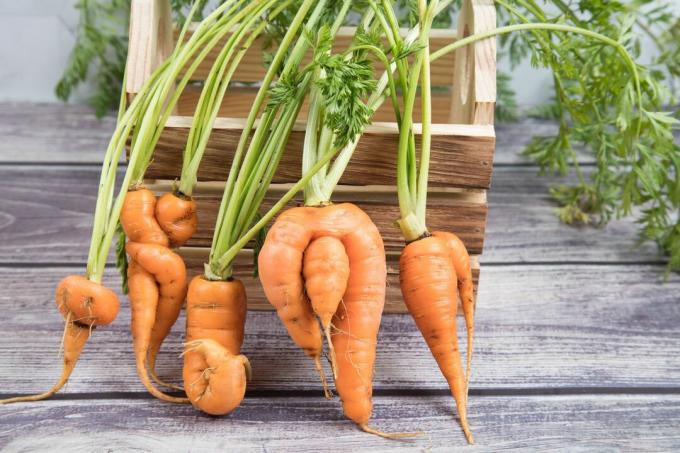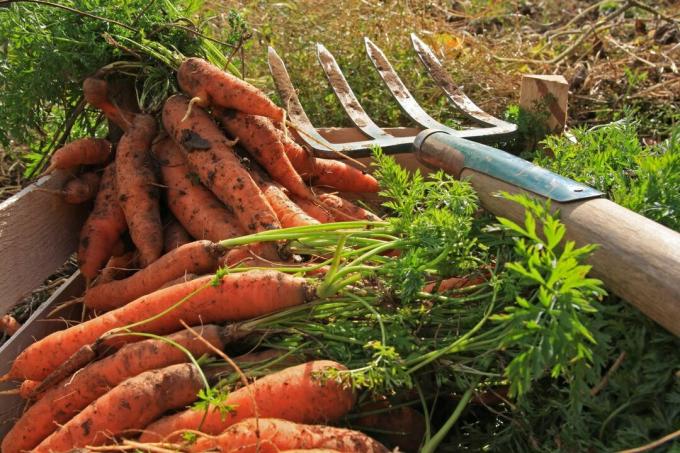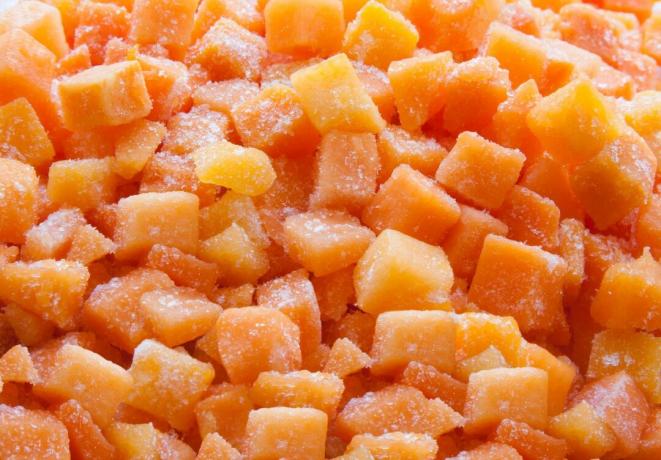Carrots can be grown well at home. Here we take a closer look at how best to proceed when harvesting and storing the popular root vegetables.

Carrots (Daucus carota subsp. sativus) can be sown over a long period of time. The harvest time is accordingly variable. Carrots that were sown at the end of February, for example, can sometimes be harvested from the end of May if the spring climate is good. So-called lager carrots sown in May remain in the ground as long as possible in autumn and are only harvested and stored before the first frost or snow.
contents
-
Harvesting carrots correctly: recognizing the procedure and timing
- The right time for the carrot harvest
- Harvesting carrots: the process
- Harvesting carrots: leave leaves on or cut off?
-
Store and keep carrots properly
- Carrots in the refrigerator
- Freeze carrots
- Pickle carrots
Harvesting carrots correctly: recognizing the procedure and timing
It is generally said that carrots can be harvested in around three months. This time of course varies depending on the prevailing weather conditions. Carrots sown in a cold March will likely take a few days to weeks longer to germinate than carrots sown in April or May. Accordingly, carrots that are sown very early will tend to be smaller and thinner if harvested after three months and should perhaps stay in the ground a little longer.

The right time for the carrot harvest
There is no right time to harvest carrots. When to harvest is, in the truest sense of the word, a matter of taste. Because the bigger the roots get, the more intense their taste becomes. Harvested earlier, the carrots are sweeter and milder and almost everyone will want to eat them unpeeled. If you like the delicious roots in all sizes, you can simply harvest as needed. You can also test how big the roots are and how they taste by harvesting a carrot every week or two.

Make sure that plants that are a greater distance from the next plant are usually already thicker than plants that are closer to others. If you feel that the carrots are not getting any bigger because they are too close together, then harvest the carrots first Take the two or more carrots away and then leave the rest of them in the bed for a few more weeks to complete.
Harvesting carrots: the process
In very sandy soil, you can simply grab large enough carrots by the leaf stalks near the root head and gently pull them out of the earth with a twisting motion. In heavier soils, you should loosen the soil beforehand, for example with a digging fork. The cavities created in the ground are closed again with earth and pressed down.

Harvesting carrots: leave leaves on or cut off?
The leaves of the carrots should be carefully twisted off immediately after harvesting and placed in the compost. Otherwise it will draw moisture out of the carrot and so it will go limp faster.
Store and keep carrots properly
Since carrots can be harvested on demand, there is often no need for long storage in many home gardens. The late carrots, which are taken out of the bed in autumn shortly before the first frost or snow, are traditionally stored in sand boxes, in earth cellars or in cool rooms.
Carrots in the refrigerator
Carrots lose moisture quickly and should therefore be stored in the refrigerator. Wrapped in newspaper or in a plastic bag with a few holes to prevent mold, the carrots will keep for a good week. Then they slowly start to shrink.
Freeze carrots
Carrots can be prepared ready to cook, i.e. peeled and cut into small pieces if necessary, or frozen. However, they change their consistency a little. However, this form of preservation is ideal for stews, to cook with in various dishes or for a soup that will be pureed afterwards anyway.

Pickle carrots
As well as zucchini, Cucumber or paprika carrots can also be pickled. The consistency the carrots take is probably familiar to you from the canned carrots. The taste can be varied very varied with the ingredients that are used for the pickling.
More tips on Preserving fruits and vegetables we present to you in this article.
